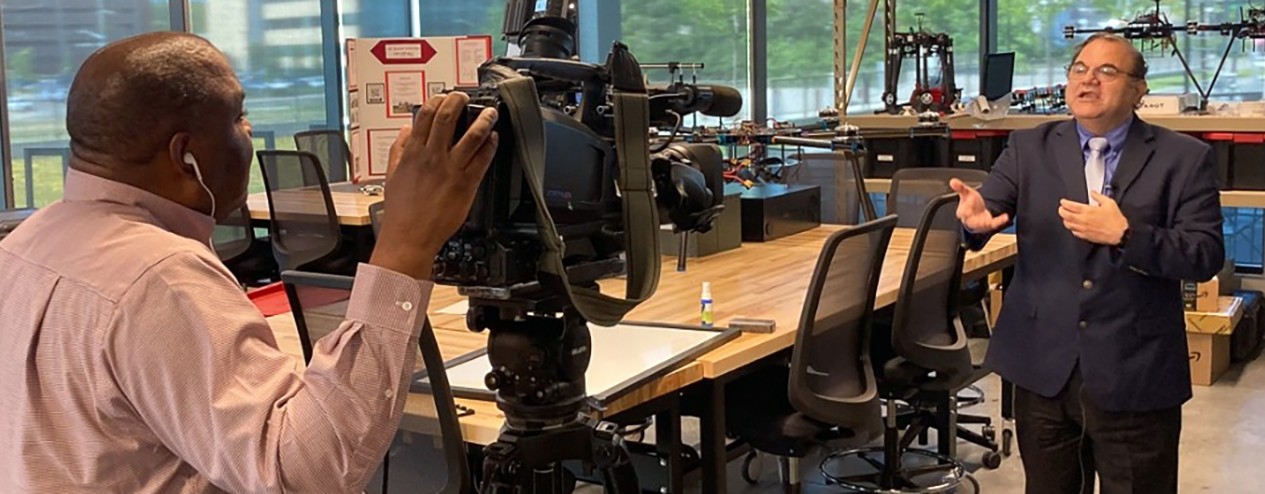
UC’s AI innovations at work
Researchers seek to capitalize on potential of artificial intelligence
It’s no secret that artificial intelligence is expected to be a game-changer in nearly every sector imaginable, from automotive to financial to health care to logistics.
According to Price Waterhouse Coopers, by 2030, the global economic impact of AI across all industries could be as high as $15.7 trillion, “making it the biggest commercial opportunity in today's fast-changing economy.”
Here at the University of Cincinnati, researchers are employing AI to gather and analyze data, to better understand human behavior and to create simulations for improved predictions. They also are seeking to improve AI decision-making, and they’re creating programs to help students and faculty harness AI for good. Here’s a sampling of UC’s AI innovations at work.
Aviation
Inside the AI Bio Lab at UC Digital Futures, Kelly Cohen, PhD, the Brian H. Rowe Endowed Chair in Aerospace Engineering, is applying fuzzy logic to develop explainable and responsible AI. His goal: to help AI reach its full economic potential by helping to ensure its trustworthiness. Cohen also is creating a 3D simulation to test sensor fusion and decision-making routines in autonomous drones, using a NASA small business grant awarded to UC and Pennsylvania company VISIMO.
Higher education
UC is teaming up with Case Western Reserve University and the Ohio Supercomputer Center on a $5.1 million National Science Foundation grant to help the state’s researchers capitalize on AI and machine learning. “One of our priorities is showing researchers how we can help them scale up their work,” said Jane Combs, associate director, Strategic Programs and Signature Initiatives, UC Office of Research.
Advanced manufacturing
Jay Kim, Ph.D., professor of mechanical engineering, has received a $300,000 grant from the National Institute of Standards and Technology to examine how artificial intelligence can aid manufacturing. First up: studying possibilities for two new fabrication plants that Intel Corp. plans to build near Columbus.
“This NIST grant will enable us to develop new innovative manufacturing technologies aligned with industry needs that will strengthen long-term U.S. leadership in manufacturing,” Kim said.
Environmental services
Ou Ma, Ph.D., the Alan B. Shepard Endowed Chair for Exploration, specializes in developing autonomous devices. Through the Intelligent Robotics and Autonomous Systems Laboratory, his team is building an autonomous robot that can not only open its own doors but also find the nearest electric wall outlet to recharge without human assistance. The innovation represents a leap forward for helper robots that vacuum and disinfect office buildings, airports and hospitals.
Health care
Vesna Novak, Ph.D., associate professor in the Department of Electrical Engineering and Computer Science, studies human-machine interaction: what machines can obtain about humans’ performance, intention and emotional states and how machines can help humans improve their health and well-being. One of her PhD students, Iman Chatterjee, taught a machine to read biometrics like heart rate and respiration to draw conclusions about conversation types. The research holds potential for providing real-time feedback for educators, therapists and others.
Nuclear and solar energy
Yu Shi, Ph.D., research associate in the Department of Chemistry, has devised a novel way to study thermodynamic properties of molten salts, which are used in nuclear and solar energy. The computational chemist and his collaborators developed a new simulation method to calculate free energy using deep learning artificial intelligence. Results could help researchers examine the corrosion that these salts can cause in metal containers like those found in the next generation of nuclear reactors.
Featured image at top: Fox19 interviews UC Professor Kelly Cohen about the future of artificial intelligence in a lab at the Digital Futures building during the North American Fuzzy Information Processing Society's annual conference at UC in May. Photo/Michael Miller
Innovation Lives Here
The University of Cincinnati is leading public urban universities into a new era of innovation and impact. Our faculty, staff and students are saving lives, changing outcomes and bending the future in our city's direction. Next Lives Here.
Tags
- 1819 Innovation Hub
- Department of Chemistry
- 1819 Innovation Hub
- College of Arts and Sciences
- Electrical and Computer Engineering
- Aerospace Engineering and Engineering Mechanics
- Office of Research
- Next Lives Here
- College of Engineering and Applied Science
- Mechanical and Materials Engineering
- Science & Tech
- Artificial Intelligence
Related Stories
Study finds police officers face higher long-term health risks
January 2, 2026
J.C. Barnes, a University of Cincinnati professor, is interviewed by Spectrum News about new research showing that the physical and psychological demands of law enforcement can contribute to earlier deaths.
Two UC-backed startups score $200K each from state
December 23, 2025
Innovative startup ventures TapIn and Saturn Sports rose from the UC Venture Lab to receive $200,000 each in funding through Ohio Third Frontier grants.
Fusion reactors may be key to uncovering dark matter
December 22, 2025
Yahoo! News highlights a new study by University of Cincinnati physicist Jure Zupan that explains how fusion reactors might create subatomic particles associated with dark matter.
